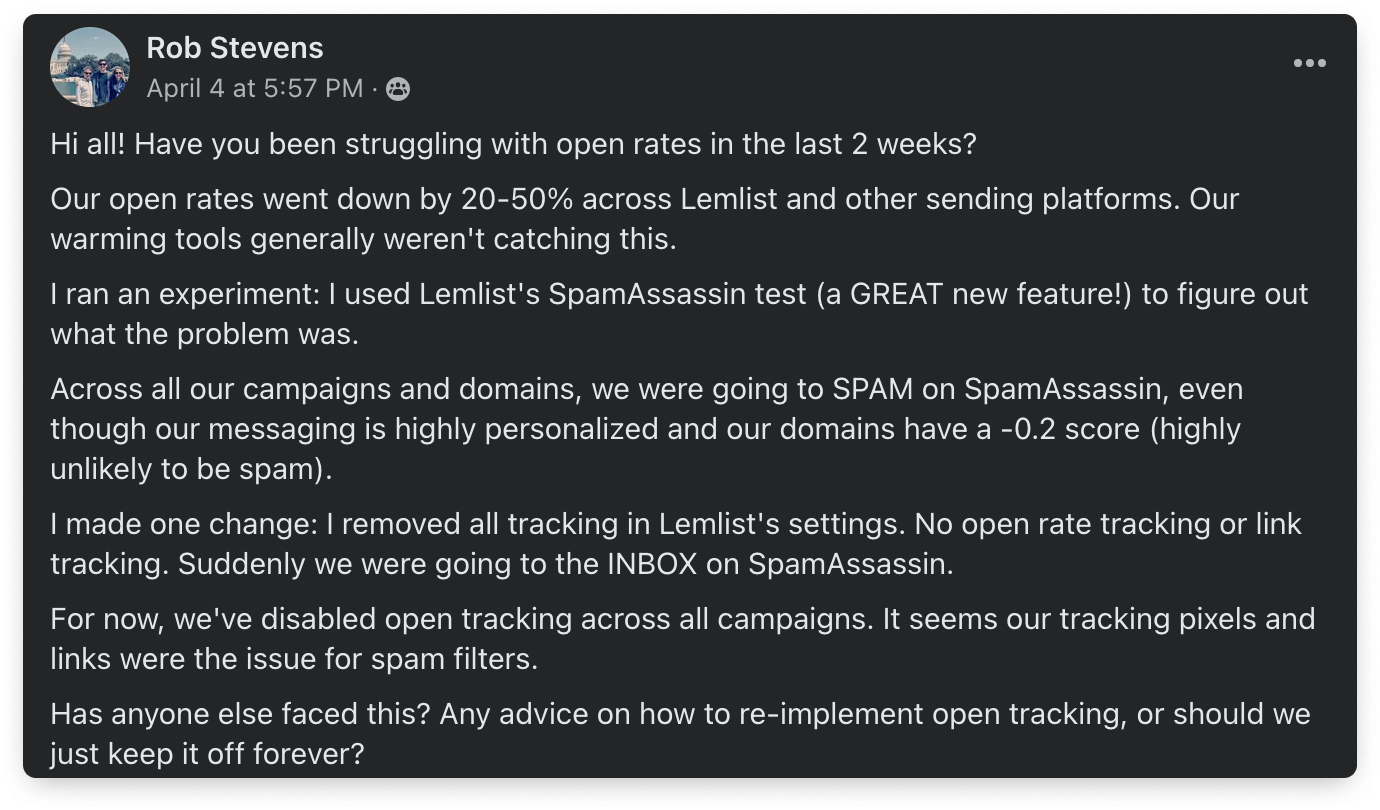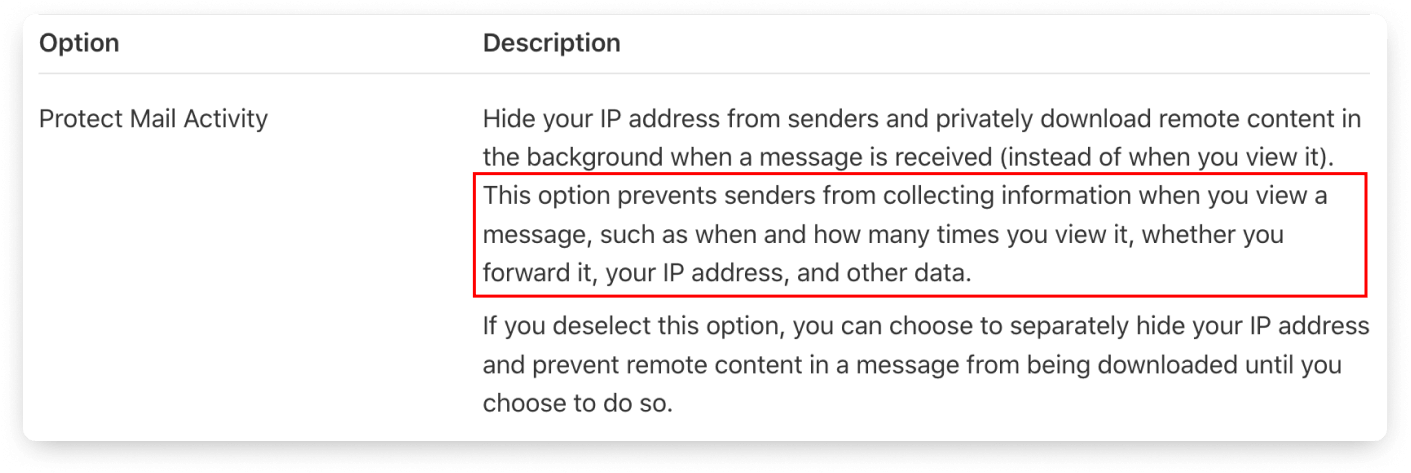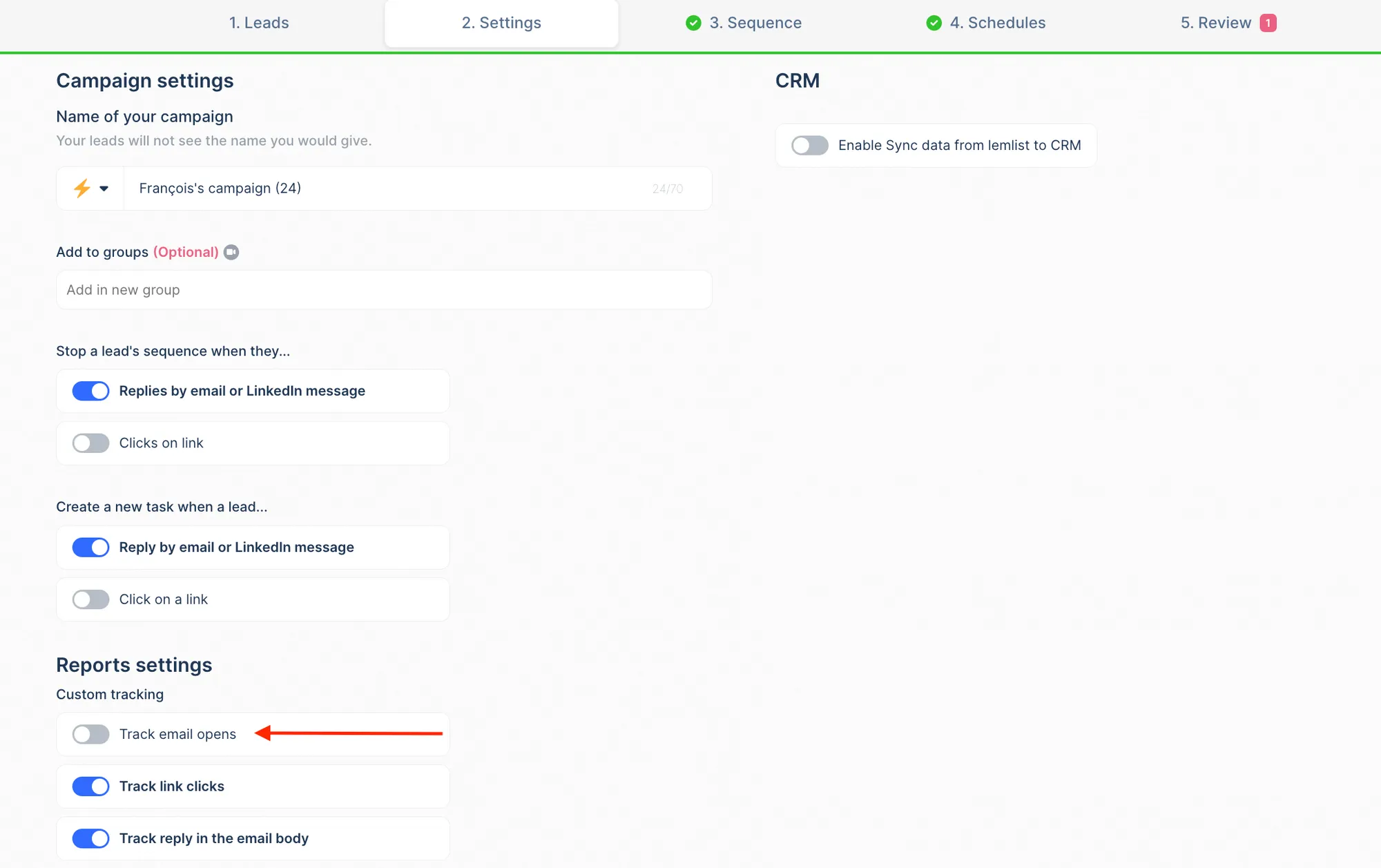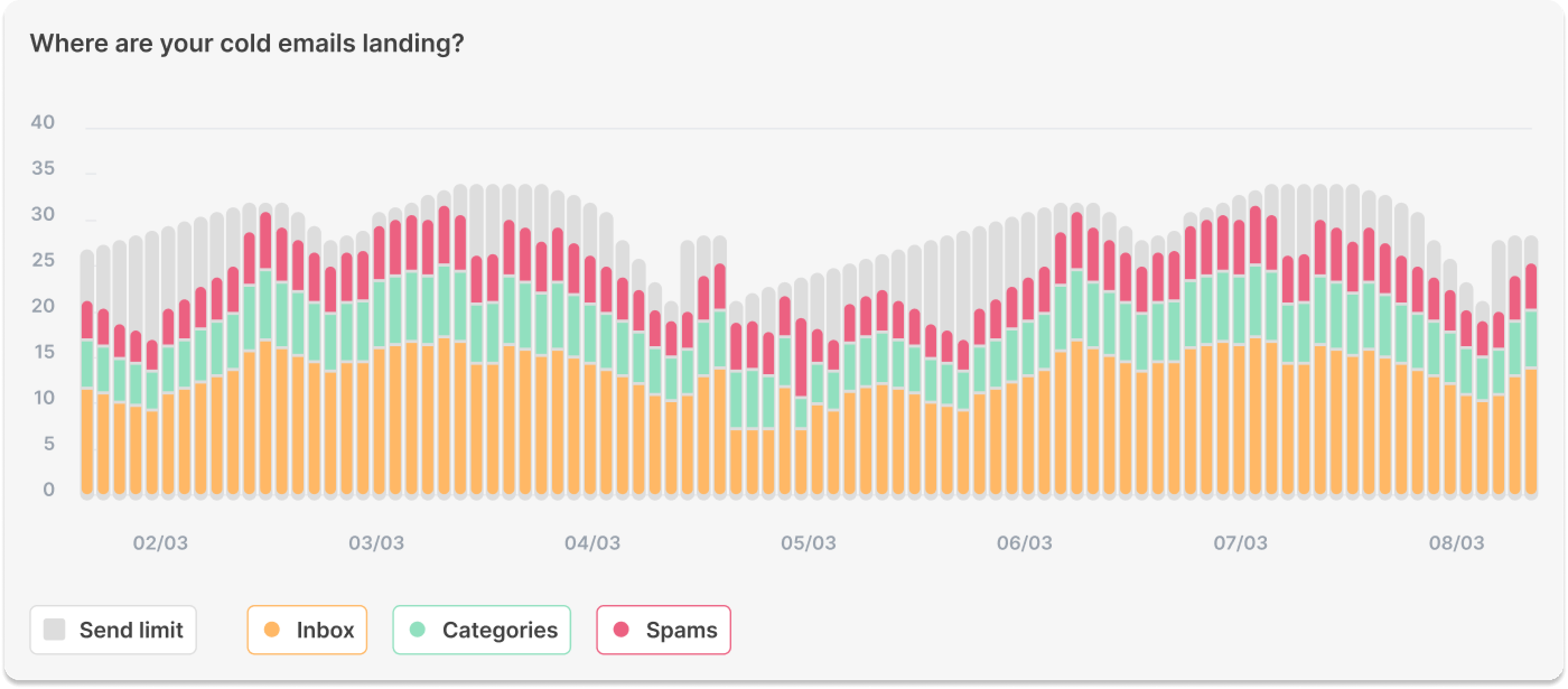Your #1 goal with cold outreach is to build relationships and increase sales, and even though we tend to focus on them, open rates don’t help you measure either of those.
And with big companies like Apple and Google cracking down on email tracking, open rates are becoming less reliable.
Instead, the metrics you need to see actual results are:
- interested replies
- meetings booked
- and business generated.
What are open rates and how relevant are they?
Open rate is the result of a simple calculation: number of emails opened / number of emails sent (percentage).
So, if you send 200 emails and 100 people open your email, you’ll have a 50% open rate. But what does that really mean…
Why have we been tracking open rates?
For years, the #1 goal of open rates was to know if your prospects were interested in what you sent them by checking if they opened it.
But in the past few years, the most important part of open rates has been to help you see if your emails are being delivered—if you are landing in the inbox or if your emails are going to spam.
We’ve always recommended having a >50% open rate, meaning you don’t have an issue with your deliverability.
But because of the new privacy updates, open rates will no longer be the go-to metric for email deliverability (we’ll get to this topic in a minute).
Another use of open rates has been to determine if your subject lines perform well or not. The logic behind this is pretty simple: if an email was opened out of all the emails in the inbox it was probably thanks to the subject line and/or the email’s first line, right?
Well, it turns out it was too good to be true.
After testing 20+ of our competitors (Salesloft, Outreach, Mailshake, Woodpecker, Reply etc….) we realized that open rates are being calculated with misleading information.
So the open rate you see isn’t a good predictor of how many people opened your email thanks to the subject line or email’s first line.
Two approaches to open rates
We find the technical explanation (don’t worry it’s not as scary as you think) to why cold email open rates aren’t working for you and solutions on the business side.
The technical explanation
To make long story short, inboxes are screwing us over.
How?
- For safety/privacy reasons, some inboxes have spam filters and bots that open your emails and click on the links you have in them. This means that it’s counted as an open or a click when actually the prospect may have never opened the email in the first place. Worse, the bots/spam filters may have put your email directly in the spam folder.
- If the email you sent is deleted (or even bounced after being opened by a bot) without the lead reading the emails, it’ll get marked as opened. Even if your lead didn’t read the message.
- Some email providers (like Outlook) have a preview mode so people can “open” the email without actually opening it, they are just moving/deleting it. So even though the lead only clicked on it long enough to move it, this counts as an open.
That means a ton of emails are being marked as opened that might not even make it to the inbox. And there are a good amount of emails being read that aren’t tracked.
But that’s not even the height of the technical problems. With the latest Google update, tracking open rates increases your likelihood of landing in spam.

How? All email tools add a pixel to your emails to track the opens. But recently we’ve seen some changes in Google’s algorithm…
So we bulk analyzed 10s of millions of cold emails sent by our 65,000+ users worldwide to make sure that having a pixel or image will not decrease your deliverability.
We found out that spam filters used by ESPs (Email Service Providers) can easily differentiate an image vs. a tracking pixel.
When a tracking pixel is used, the likelihood of your emails landing in SPAM was 15% higher than without tracking.
However, images did not impact the deliverability at all.
The business metrics that matter
Don’t worry, by not tracking open rates you aren’t losing any vital information.
The truth is that open rates have nothing to do with the success of your outreach or the growth of your business.
Instead, here are the most important metrics you should focus on:
- Business generated (dollar bills y’all)
By far the best metric to focus on is how successful your campaign ultimately was.
You’re measuring the amount of prospects that made their way through the entire sales funnel and that have acquired your product or service.
- Qualified meetings booked
Your campaign has been successful, it’s attracted the attention of your prospects to the point where they’ve set aside time out of their day to meet with you.
Here you know the impact of your campaign and your product or service.
- Interested reply rates
With interested reply rates, you’re able to measure how appealing your campaign is to your prospects.
If they’ve shown interest in your first approach, you know that your campaign is successful at first, but maybe needs tweaking further along the sales funnel.
Opens and clicks are vanity metrics. They’re just assumptions that people are interested in what you’re offering. But the truth is that these assumptions are misleading because of the technical explanation above.
Positive replies, meetings booked, and business generated are pure signs that your targeted prospects are interested. These are much more reliable and are related to business growth.
Track your Inbox Placement Rate
The inbox placement rate (IPR) is a metric that measures the percentage of emails that successfully land in recipients’ inboxes.
It indicates the effectiveness of an email campaign in reaching its intended audience and avoiding email deliverability issues.
Monitoring and optimizing inbox placement rate is crucial when cold emailing to ensure that your messages reach your leads’ inboxes.
Ultimately you are measuring your deliverability.
Deliverability is a key component of your outreach campaigns, but you should track this using your deliverability and warm-up booster (like lemwarm) instead of looking at metrics like open rate.
To keep track of the business metrics and deliverability, we suggest updating your cold outreach tool to track qualified replies (interest rate for lemlist users) and also making sure it shows where your emails are landing.
You can even sync your outreach tool with your CRM so deals are automatically created when someone is interested, and then you’ll be able to see the qualified meetings booked and the business generated.
This way the result of your campaigns is clear and available for you and your team!
Where is tracking open rates leading us?
How long will other metrics be reliable and what’s going to change?
How things have changed recently…
Every year we are moving towards increasing privacy regulations. Lately, GDPR (in Europe), CCPA (in California), and regulations in other places are limiting the data we can track.
An example is these cookie popups you might come across when you open a website…

Then, you have companies like Apple that decided to cut their email tracking to protect the privacy of their users. And lots of other big companies are following suit.

Again, this makes your open rates completely unreliable.
And potentially…
Honestly, this decrease in tracking and increase in privacy is only going to continue. But this gives us a huge opportunity to focus on what really matters: generating sales and building relationships.
And you can do that by focusing on the metrics that matter and therefore bringing the most value possible to your prospects.
The good news is that the most successful lemlisters don’t currently rely on the vanity metrics to be successful, and you don’t need to either.
At lemlist we’ve always had your back to give you the best new sales prospecting tactics and use the best techniques to keep all your emails out of spam.
- We were the first to create a tool like lemwarm with the biggest network of inboxes in the world to help you get the best deliverability on the market.
- We were the first to test advanced sending algorithms to increase your deliverability.
- And of course, we were the first to add next-level personalization (that was actually scaleable).
And now we’ve got a new first.
We think this is going to be a time of change for measuring and tracking email campaigns.
And by changing this for your campaigns you’ll be rewarded by inboxes, and get better results.
We’ll talk more about it in our coming articles and in the lemlist family community, but for now…
What should you do to improve desired metrics?
This article’s been a bit of a bummer, but I have good news.
There is a step-by-step process you can follow to keep you out of spam and boost your outreach results (AKA generate more business). Check it out:
On the tech side
- Turn open rate tracking off in your cold outreach tool to increase your deliverability.

- Focus on all the other important factors of deliverability.
- Keep lemwarm on at all times to boost your deliverability.

If your emails are landing in spam even with lemwarm ON, it may mean that your deliverability would be even worse without lemwarm.
If you turn it off you will see a drop in your deliverability!
Remember, the main goal of open rates is to know more about deliverability. So, by creating lemwarm account, you’ll easily be able to tell where your cold emails are landing.
And to discover more about how deliverability boosters help you land in the inbox and open new business opportunities, check out this article.
On the business side
Remember, your goal is to increase business. Open rates have nothing to do with this, and you’ll get much better results focusing on these instead!
- Focus on the right metrics: business generated, qualified meetings booked, interested replies.
- Focus on targeted leads: only reach out to leads you can really help!
- Focus on sending quality outreach: use high personalization, low sending limits, and try multichannel tactics to build relationships.
Key Takeaways
Alright y’all, that’s a wrap. To sum it up:
- Now is the time to start tracking your email deliverability
- Stop tracking open rates to increase deliverability and land in the primary inbox
- Focus on the best deliverability factors (technical setup, targeting, sending limits, etc.)
- Close more deals by looking at metrics that are pure interest signs (interested replies, meetings booked, business generated)

If you’re looking for a step-by-step explanation on how to manage deliverability and create lemazing cold email campaigns that generate business, check out our cold email masterclass.
Your source of actionable outreach tips and strategies that will help you get replies and grow your business.

